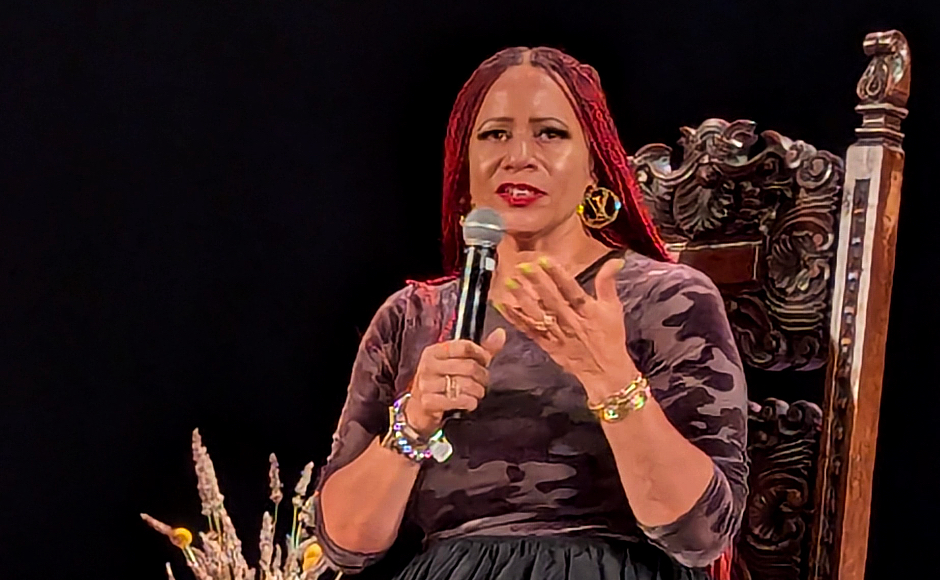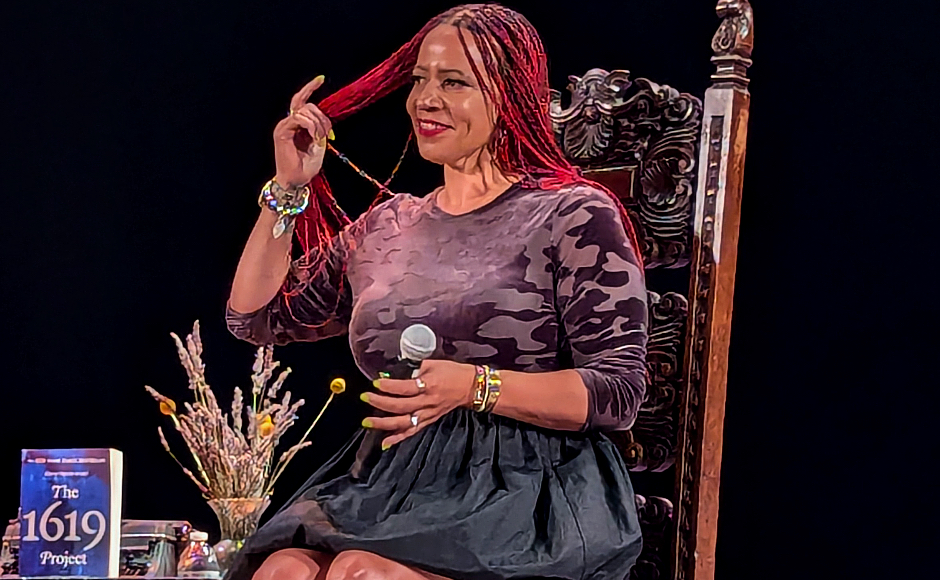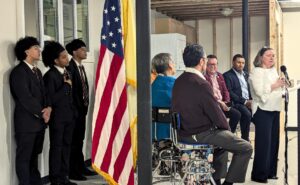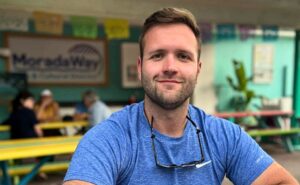The journalist and author of The 1619 Project: a New Origin Story visited the borough in conjunction with its paperback release.
By Matt Skoufalos | July 10, 2024

Ida B. Wells Barnett, in a photograph by Mary Garrity from 1893, restored by Adam Cuerden. Reproduced by Wikimedia Commons in the public domain.
Even before taking her first steps into a journalistic career whereby she would earn national acclaim, Nikole Hannah-Jones fell in love with her “spiritual godmother,” renowned American journalist Ida B. Wells-Barnett.
“When I was young, she was one of the handful of Black people you learn about in Black History Month,” Hannah-Jones said of Wells.
“They said she was a journalist and activist, but they didn’t really say what her activism was about.”
An investigative journalist, educator, and civil rights leader whose career spanned the Reconstruction Era, the Plessy vs. Ferguson “separate but equal” Supreme Court decision, and the women’s suffrage movement, Wells was born into slavery in Mississippi.
In her lifetime, she endured the loss of both her parents and a sibling to yellow fever, the lynching of her friends, the destruction of her own newspaper, The Memphis Free Speech, by white supremacists; and critiques of her activism by comrades in the women’s suffrage and civil rights movements.
When Hannah-Jones discovered Wells’ autobiography, Crusade for Justice, as a college student, she met “a woman who didn’t take any mess.” Denouncing classism as strongly as she did racism and misogyny, Wells also lived a complicated, human life, courting lovers and occasionally shopping to the point of falling behind on rent.
“She really became this almost avatar of what I wanted to be one day,” Hannah-Jones said. “The more I learned about her, the more I understood. She was a truth-teller. She went from going into debt for clothes when she was young to going into debt to help the least of her people.”
In 2020, Wells was posthumously awarded a Pulitzer special citation for her “outstanding and courageous reporting” during the lynching era. The announcement came during the same year that Hannah-Jones, cofounder of the Ida B. Wells Society for Investigative Reporting, won her Pulitzer, and “cried like a baby” at the shared moment.
“When she was alive, she was the most famous black woman in America,” Hannah-Jones said. “Now her name is one that we recognize again.”
Like Wells, Hannah-Jones has reported extensively on issues of race, segregation, and the social structures that uphold racist institutions.
A decorated journalist — in addition to the Pulitzer in 2020, Hannah-Jones has won a George Polk Award for radio reporting (2016) and a MacArthur Foundation fellowship (2017) — her visit to Collingswood coincided both with Wells’ birth month and the paperback release of her seminal work, The 1619 Project: a New Origin Story.
Hannah-Jones’ appearance was sponsored by the Jeannine Cook of Ida’s Bookshop, the Collingswood bookseller named in Wells’ honor, with use of the Scottish Rite Theater donated by the Borough of Collingswood. The first 100 attendees received copies of The 1619 Project purchased and donated by the Collingswood Education Association.
In addition to drawing considerable plaudits, the work, which reframes the colonial origins of America in terms that emphasize the prominence of chattel slavery as a motivating force in the emergence of the nation, has faced scrutiny from some historians alternately for making such a claim in light of contravening evidence, and also for the complications it presents to centuries of established (and white-male-dominated) scholarship on the issue.
In a 2019 essay in The Atlantic, Adam Serwer sums up the critique in terms described by Black historian W.E.B. Du Bois, who argued “…that much of American history has been written by scholars offering ideological claims in place of rigorous historical analysis. But which claims are ideological, and which ones are objective, is not always easy to discern.”
Hannah-Jones’ work blends both. Her 2019 essay, “Our Democracy’s Founding Ideals Were False When They Were Written. Black Americans Have Fought to Make Them True,” which opens The 1619 Project, details her lineage from Mississippi sharecroppers who discovered that “Jim Crow did not end at the Mason-Dixon line” when they settled in a segregated Iowa neighborhood in the 1940s.
Military service wouldn’t offer her father, Milton Hannah, an escape from the poverty that he had been born into, just as the civil liberties enshrined in the 13th, 14th, and 15th Amendments to the U.S. Constitution didn’t protect other Black Americans from the effects of the systemic racism they endured in civilian life for generations.
“For centuries, white Americans have been trying to solve the ‘Negro problem,’” Hannah-Jones wrote. “They have dedicated thousands of pages to this endeavor. It is common, still, to point to rates of black poverty, out-of-wedlock births, crime and college attendance, as if these conditions in a country built on a racial caste system are not utterly predictable. But crucially, you cannot view those statistics while ignoring another: that black people were enslaved here longer than we have been free.”
Before the crowd at the Scottish Rite on Tuesday, Hannah-Jones spoke about her feelings of hopelessness in the historical context of those institutions, and how they underscore the lingering effects of structural racism in America today.
“Here were are in the Northeast, and we like to pretend that the Northeast was the abolitionist, progressive part of the country,” she said. “New Jersey was a slave colony and a slave state. Slavery was in New Jersey until the Civil War, and was followed in New Jersey by a system of Jim Crow; we just don’t call it that.”
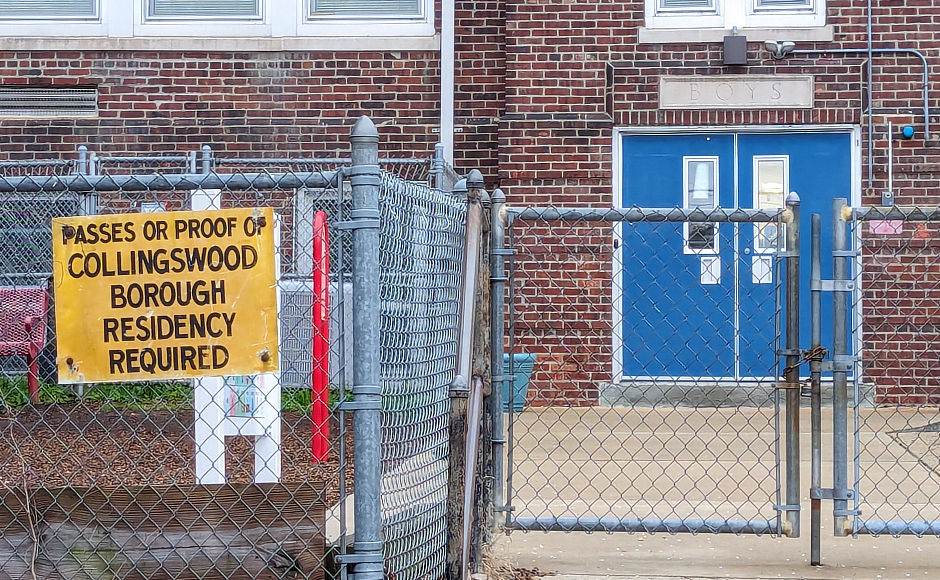
“Passes or Proof of Collingswood Boough Residency Required” reads a sign outside of Sharp School in Collingswood, the only majority-minority elementary school in the district, as seen in April 2024. Credit: Matt Skoufalos.
The long tradition of home rule in New Jersey gave rise to economic segregation that has lingered in its education system long after its 1947 constitutional amendment integrating schools.
In the 2016-17 school year, about 63 percent of the 585,000 Black and Latinx students in the state attended schools that were more than 75 percent non-white, and 46 percent attended schools that were more than 90 percent non-white.
“School segregation in New Jersey is not only by race, but it is double segregation by race and
Poverty,” the 2017 study reads — noting a “triple segregation” in the form of linguistic isolation for English-language learners — “with black and Latino students in schools with far poorer classmates—conditions research shows to be linked to educational inequality.
“There have been no significant efforts to change these patterns,” it continues. “Because the commitment of the courts has been to create schools that are more equitable solely in terms of dollars and programs, segregation has gone unchecked. Without any statewide effort to integrate schools, segregation has surged as the racial transition of spaces across New Jersey continues.”
That segregation is the long-held norm in New Jersey was the basis of the 2017 school integration lawsuit, Latino Action Network vs. State of New Jersey (summarized here by Chalkbeat), in which the plaintiffs argued that residency requirements have segregated schoolchildren across the state, subverting their access to a “thorough and efficient” public education vouchsafed by the state constitution.
More recently, however, the latest Student Safety and Discipline in New Jersey Public Schools report from the New Jersey Department of Education identified the impact of that segregation on disproportionate discipline of non-white students throughout the state: despite accounting for a minority of students in the state, Black and Hispanic students are more frequently suspended, and their behaviors referred to police, than are their white counterparts.
Hannah-Jones attributes findings like these to the acceptance of “a racial caste system in the United States that says what you have, where you can live, and what sorts of discipline you will face in schools.
“You either believe that Black children are just worse than other kids, or you say, in a country that for more than 200 years didn’t give Black people any rights in society… perhaps there’s something wrong with the society and not the kids,” she said.
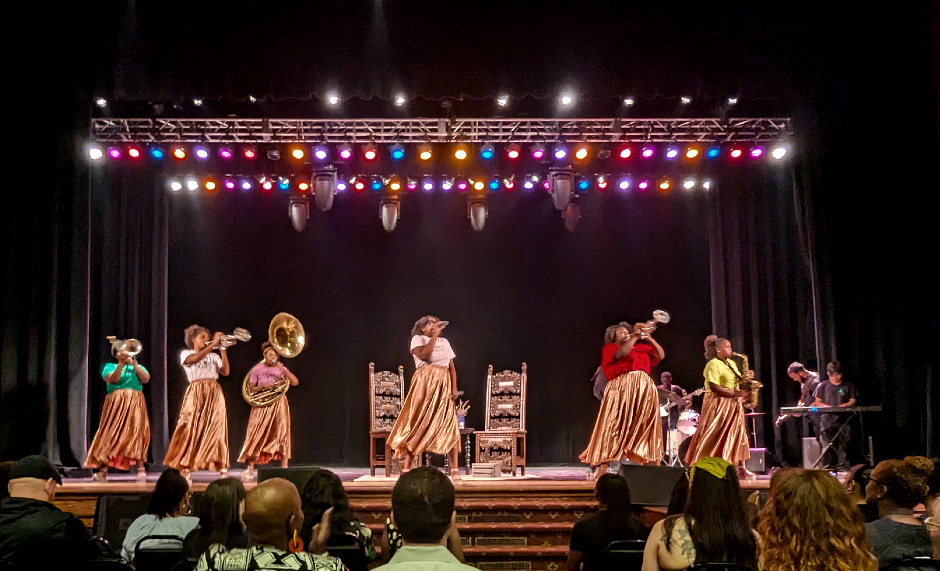
Trumpet Chics perform for writer Nikole Hannah-Jones at the Scottish Rite Theater in Collingswood. Credit: Matt Skoufalos.
“All these things you see in your society, they have been created,” Hannah-Jones said.
“The society we have has been built. It’s not normal; it’s not natural. It can be taken down brick by brick.
“The problem is, are there really enough of us who want it to change?”
In trying to reach an audience that will consider those issues, Hannah-Jones said her work “has really been geared towards the white liberal, the white progressive, the person who says all the right things.”
She described working to illustrate the ways in which systemic racism often is maintained by the individual choices of well-meaning people who hold intellectually ethical values that they do not themselves practice.
“I talk about race because race distorts public policy for everybody in America,” she said. “It hurts us the most, but it hurts so many white folks too. Whiteness is a construct created to order our society to have political, economic, and social power. If we could get rid of that, we could actually make America great for the first time.”
After the conclusion of the program, Hannah-Jones spoke with NJ Pen about the difficulty many communities face in working to dismantle the unconscious bias of racism in public institutions, specifically in public schools.
In her experience, administrations that try to address the effects of structural racism “don’t typically last long,” Hannah-Jones said, because “the support is never that strong in the first place.” Serious reforms, she said, can often be undone by the (mis)behavior of a single student, particularly if that student is not white.
“Reformers don’t last long in these leadership positions,” she said. “You have to have strong school board support, and you have to have strong community support for when the attacks come when leadership is trying to make the change.”
In Collingswood, Black and brown high-school students walked out of class last year in protest of the disproportionate discipline they claimed they were facing from an almost uniformly white district staff, which data in the Student Safety and Discipline Report bears out.
Their protests haven’t yet translated into lasting cultural improvements in the district, despite engendering open public discussions and testimonials from Black borough residents about the legacy of bias they’ve experienced locally for decades.
“Very few places have ever been willing to do the work to address the issues,” Hannah-Jones said.
“The reason I became a journalist is having some hope that, if people actually understand the history behind how we got here, how these structures were put in place that led to the disparities, that then can drive policy changes that address those disparities. And I feel most times that I’m screaming into the abyss.”
“You don’t see these issues in every single community where Black children live without that being deeply embedded in the society, and structural,” she said. “There’s not a lot of courage around these issues, and there’s not a willingness to do what’s necessary for sustained change.
“I commend the students for not accepting it; for protesting,” Hannah-Jones said. “Things will not change if there is not a struggle against it.”

